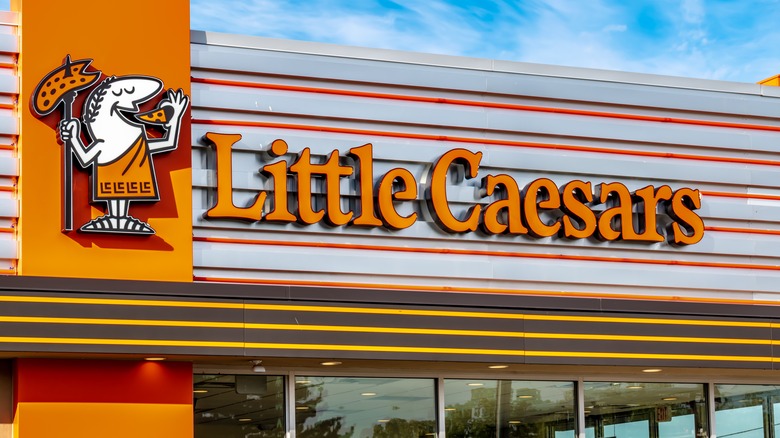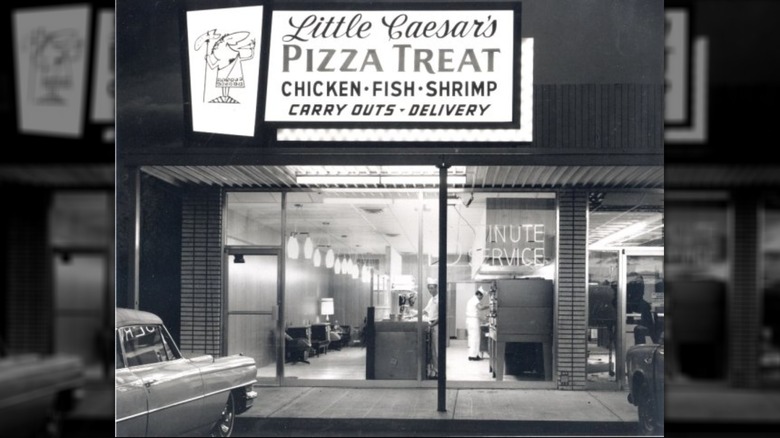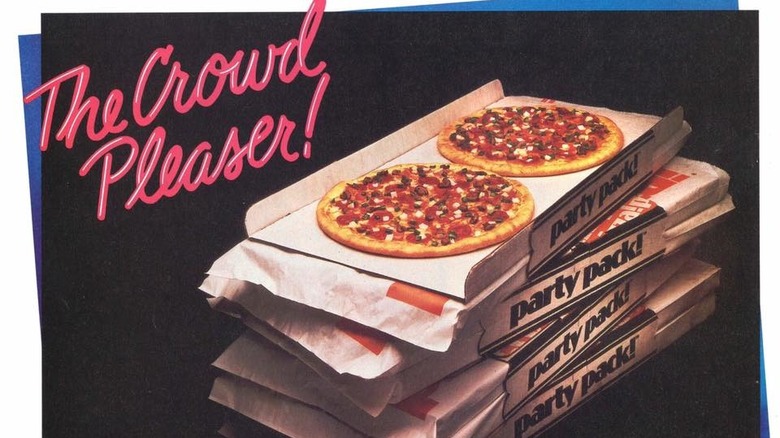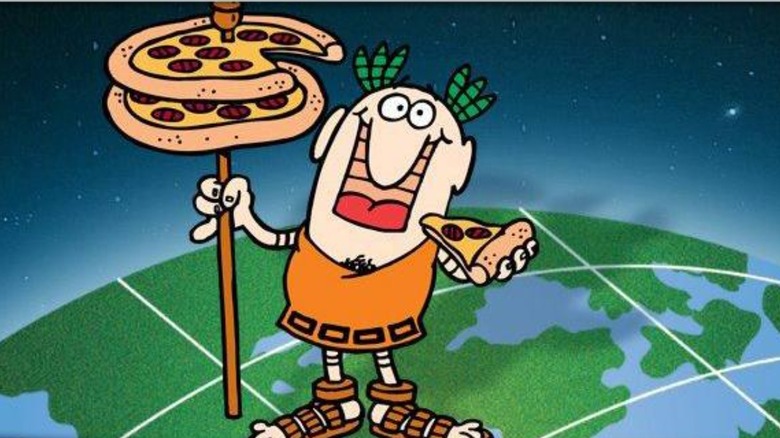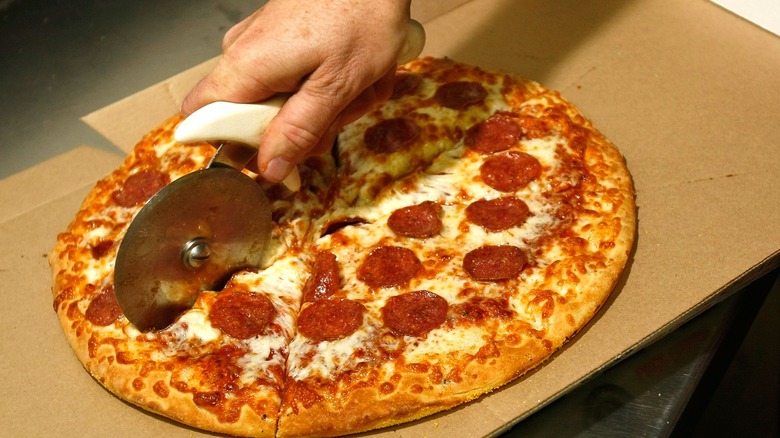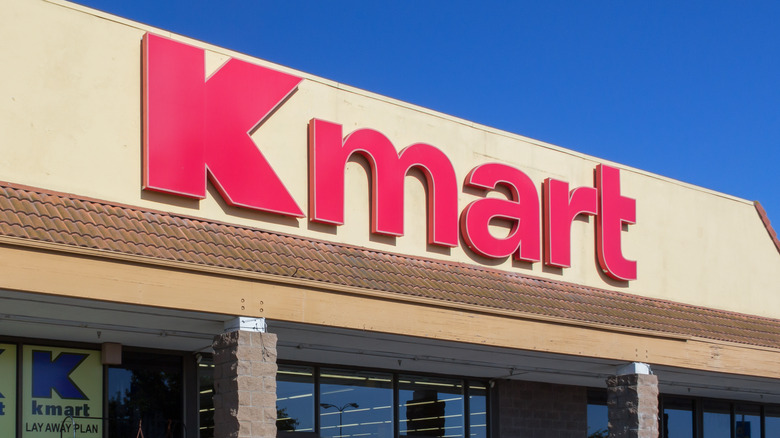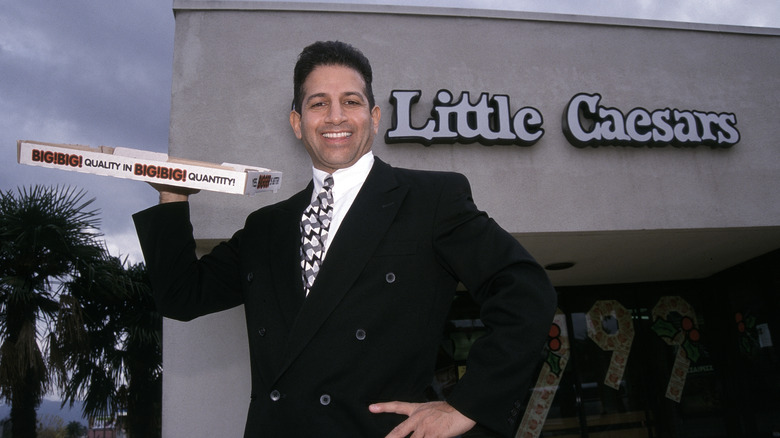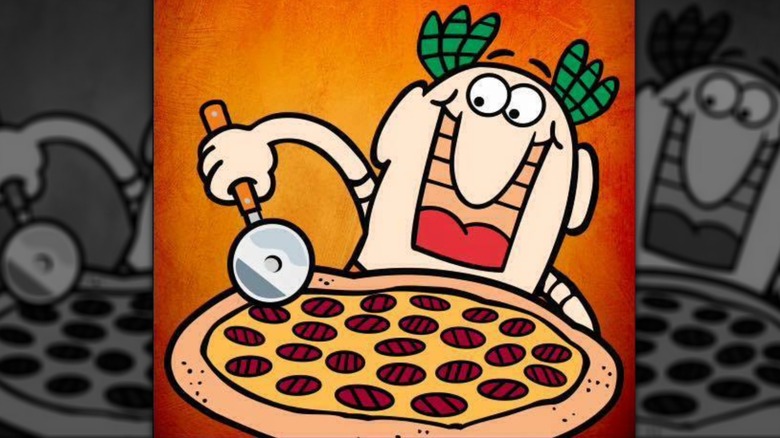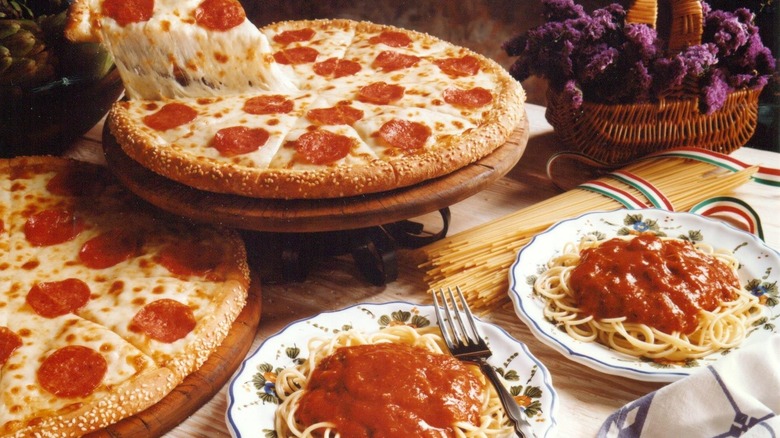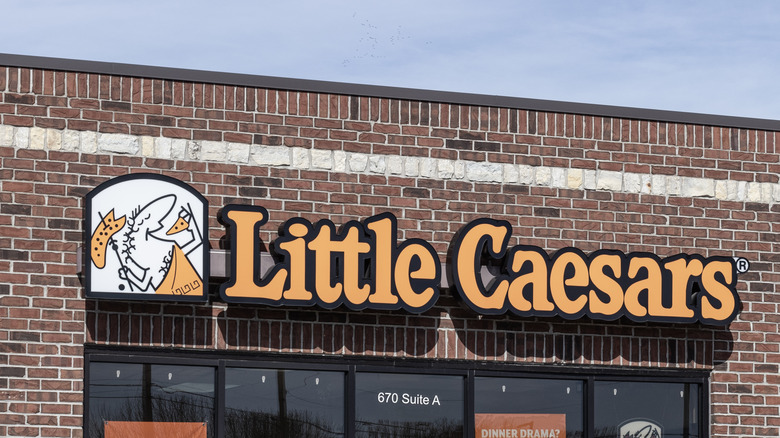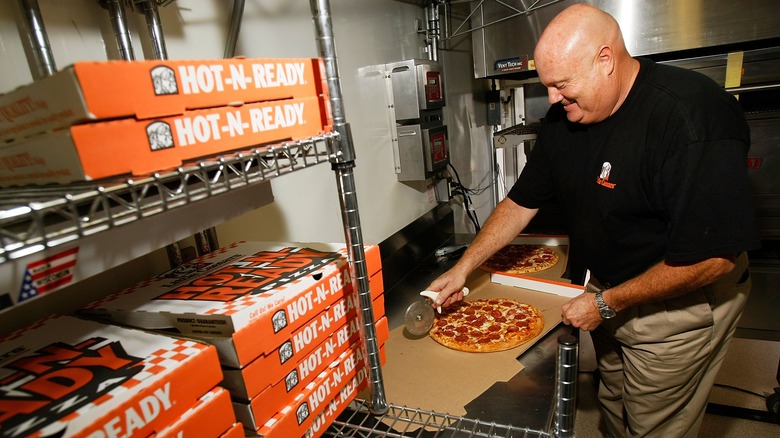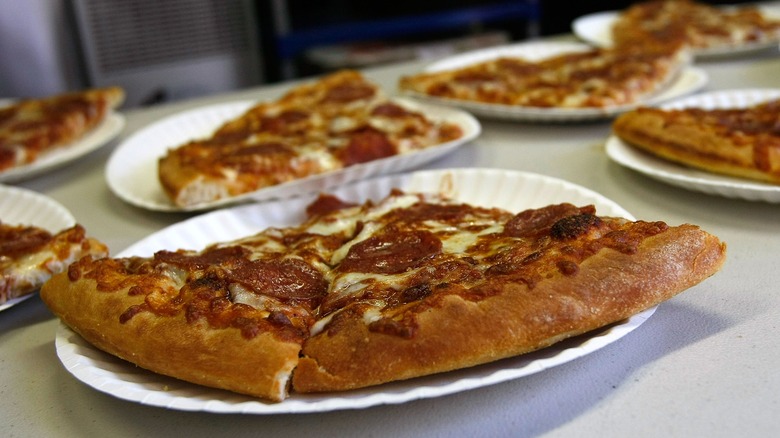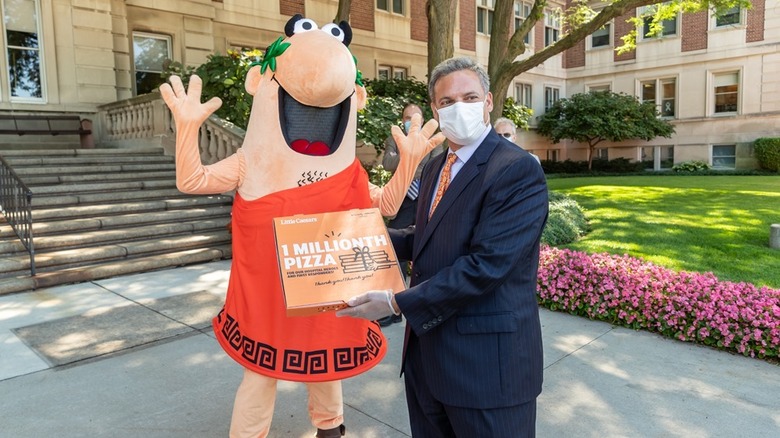The Rise, Fall, And Rise Again Of Little Caesars
The story of Little Caesars is one of extraordinary ups and downs. From the beginning, the pizza chain found its niche in the market, becoming known far and wide for its reasonably priced pies. It isn't the best pizza you've ever had — not even close — yet, for many of us, it was the pizza of our childhoods, a staple at birthday parties and after-school sports games. Huge, cheap, and quick, Little Caesars' pizza was the go-to for countless budget-minded families.
Since its inception in the 1950s, Little Caesars has been an unstoppable force in the fast food industry, proving there is a hunger for hot, affordable pizza. It quickly reached incredible heights, expanding all over the country and worldwide. Successful marketing, such as the chain's cartoon mascot, wacky commercials, and unforgettable "Pizza! Pizza!" slogan, turned Little Caesars into a highly recognizable brand.
However, all this momentum would not last. Several bad moves set the company back at a time when competition was fierce. Little Caesars seemed to lose sight of what made it stand out, and consequently, so did consumers. Just as things were looking bleak, the company launched an impressive comeback, returning the chain to its roots and simultaneously updating it for the present day. Follow along as we explore Little Caesars' initial success, the missteps that threatened its failure, and its remarkable return to greatness.
The first Little Caesars opened in Michigan in 1959
Little Caesars was born back in 1959, when couple Mike and Marian Ilitch opened a pizza restaurant in Garden City, Michigan. Taking a huge risk, they sunk their family savings into the project. The first restaurants were called Little Caesar's Pizza Treat, a name that was later simplified. Pizza wasn't the only thing on the menu back then. The restaurant also served hot dogs, chicken, fish, and shrimp, though these items disappeared as the Little Caesars brand developed its identity.
Three years later, in 1962, Little Caesars opened its first franchise in Warren, Michigan. The franchising model proved successful, and the company moved to expand and spread. By 1969, there were 50 locations nationwide, with the first international location opening in Canada. With its memorable mascot and speedy service, Little Caesars quickly became one of the top pizza chains in the U.S.
Little Caesars became known for its great deals
From the beginning, Little Caesars set itself apart by having the lowest prices. In 1971, Mike and Marian Ilitch even bought a mushroom farm to meet their company's demands and control costs. Little Caesars Mushroom Farms, Inc. eventually ventured beyond just mushrooms, becoming a major distribution company for all types of foods under the name Blue Line Foodservice Distribution.
Then, in 1979, Little Caesars introduced a special deal: Two pizzas for the price of one. To advertise this promotion, Little Caesars came up with the slogan "Pizza! Pizza!" to indicate that customers would be getting double the pie with their order. This catchy phrase would later become synonymous with the brand. Little Caesars' memorable TV ads made "Pizza! Pizza!" a well-known phrase in households across the country.
Future promotions would continue this trend, cementing Little Caesars as the pinnacle of affordability and convenience. This niche proved to be the brand's key to success. By differentiating itself from local pizza shops and other growing chains like Pizza Hut and Domino's, Little Caesars built up a loyal customer base that was only getting bigger.
The chain saw explosive growth
In 1985, Little Caesars was the largest carry-out pizza company in the U.S., with 1,000 stores and counting. The chain was expanding at an extraordinary rate, opening restaurants in all 50 states by the end of the '80s. It was also around this time that the company reached $1 billion in sales.
By 1990, Little Caesars had 2,700 locations, more than double the number just five years prior. This same year, an independent survey of national chains named it the best value in the country (though it placed second in customer satisfaction in the pizza-specific section). Little Caesars continued ahead at full speed and by 1993, it boasted 4,500 restaurants and $2.3 billion in sales.
This remarkable growth was thanks to the chain's low prices and focus on takeout pizza, which gave it a leg up on the competition. Other pizza chains couldn't match Little Caesars' price point. They also emphasized delivery, while Little Caesars went all in on the less expensive carry-out model. The company also smartly invested a lot of money in advertising, planting "Pizza! Pizza!" firmly in the minds of adults and children everywhere.
Competition hurt the company's sales
In the '90s, the three largest pizza chains went to war. While Pizza Hut had always led the charge, Little Caesars fought hard for Domino's spot in second place. The chains worked to outdo each other and fill the niche of the best-value pizza. In 1993, Little Caesars launched the Big! Big! Cheese Pizza, a massive 24-slice pie sold for only $8.88. Pizza Hut quickly came out with its own similarly priced 24-slice pizza, called the Bigfoot. To keep up, Domino's introduced the Dominator, a 30-slice monstrosity that was so big it couldn't be delivered.
However, where Pizza Hut and Domino's had been battling to be the best in delivery, Little Caesars primarily stuck to takeout. In 1994, after a long period of growth, Little Caesars' sales finally stagnated while its rivals surged ahead. Not to be outdone, Little Caesars threw itself into the delivery game, albeit a little too late. Delivery was a costly venture, and the competition already had it streamlined down to a science.
Domino's and Pizza Hut also continued to innovate, focusing more on quality than just quantity. For example, in 1995, Pizza Hut's cheese-stuffed pizza crust resulted in record-breaking sales for the company. Consumer tastes were changing, and Little Caesars couldn't keep up with the competition.
A partnership with Kmart had mixed results
In 1997, Little Caesars partnered with Kmart to become the main supplier for its in-store restaurants. Around 500 stores already featured the pizza chain. Now, shoppers everywhere could stop to enjoy a pizza or two before getting on with their day. Kmart, then boasting over 2,100 stores nationwide, offered incredible reach for the pizza chain. But Kmart's sales soon plummeted and in 2002, Kmart filed for Chapter 11 bankruptcy.
The mass Kmart closures that followed resulted in the loss of many in-store Little Caesars restaurants. This was a huge blow to the pizza chain, which wasn't doing so hot either. Its contract with Kmart expired, and the remaining in-store restaurants gradually disappeared with their hosts. In the years to follow, Kmart would come out of bankruptcy intact, transformed through a merger with Sears (though both retailers eventually closed most of their stores). Meanwhile, in a twist of fate, Kmart's competitor Target launched a successful partnership with Pizza Hut, one of Little Caesars' main rivals.
Little Caesars parted ways with its advertising agency
Little Caesars was always known for its wacky, fun advertising. You may have memories growing up of watching silly skits of conga line dancing, hand puppets, and talking dogs. Childish, yes, but it was a core part of the brand's identity. This was all the work of Cliff Freeman & Partners, Little Caesars' long-time advertising agency. The New York-based agency, tied to the pizza chain since 1986, also created and popularized the famous "Pizza! Pizza!" slogan.
When Little Caesars' sales stagnated in the mid-90s, the company decided to decrease funding for advertising. It went from spending $53 million in 1996 to $34.6 million in 1997. This was an odd move, given that its advertising put the chain on the map. To compare, in 1997, Pizza Hut allocated $147 million for advertising.
Then, in 1998, Little Caesars announced that it was parting ways with Cliff Freeman & Partners. While it was reportedly amicable, the split occurred due to differing opinions on how to approach the company's growing problems. Little Caesars remained optimistic that a new agency could herald it into another era of marketing success.
Ineffective marketing led to an identity crisis
In the '90s, Little Caesars' signature humor-based marketing wasn't as effective as it once was. With rising competition in the pizza industry and evolving consumer tastes, Little Caesars' silly ads just weren't cutting it anymore. In 1995, the company introduced the Italian Kitchen concept, a version of the restaurant that served pasta, salad, and dessert in addition to pizza. Around this time, Little Caesars also pivoted toward delivery and larger pizzas. Advertising moved to focus on these new initiatives, phasing out the classic "Pizza! Pizza!" tagline in the process. According to former franchisee Jeff Welsh in an interview with Ad Age, all this change resulted in inconsistent messaging. "The customer doesn't know who Little Caesar is anymore," Welsh lamented.
After Little Caesars split from Cliff Freeman & Partners in 1998, it turned to Bozell Worldwide (later called FCB Worldwide) for its advertising needs. The new agency attempted to fix the brand's marketing crisis by launching a national ad campaign. The ads, which ditched the silliness to emphasize the pizza's quality, ultimately failed to captivate their audience. The new messaging wasn't strong enough to reestablish and unify the Little Caesars image in consumers' minds. Plus, with Papa John's now on the scene and applying even more pressure, competition was more cutthroat than ever.
Little Caesars alienated its struggling franchise owners
By the late '90s, Little Caesars franchisees were growing increasingly frustrated with decisions made by the corporate office. Many blamed declining sales on the company's lack of direction. One franchisee explained, "We got into spaghetti and dumped that. They told us to dump fountain service and get rid of the equipment, then told us to bring it back, and they abandoned the Italian Kitchen." All this back and forth was bad for business.
In 1999, more than 250 franchisees banded together to file a class action lawsuit against the chain, accusing the company of unfair treatment. Up to this point, franchisees were required to contribute 4% of their gross sales to national advertising, an amount that many couldn't afford. With Little Caesars spending less and less on advertising, franchisees felt that their contributions were unreasonable. Plus, the brand's current advertising wasn't as effective at bringing in customers. Stores saw fewer sales, and many were forced to declare bankruptcy or drop the Little Caesars name.
The lawsuit also accused the chain of supplying stores with low-quality ingredients. Franchisees, who had no choice but to source ingredients from Blue Line, the company-owned food and supplies distributor, alleged that they were sold inferior products at overly marked-up prices. Little Caesars denied this claim.
Many locations suddenly closed
On one summer night in 1999, Little Caesars suddenly closed over 400 stores. Thousands of workers were left unexpectedly unemployed, with some arriving for work only to find their stores shuttered. Franchised restaurants were not affected, however. Little Caesars denied that the closures were a sign of financial hardship for the company, and according to the corporate office, it was all part of a plan to remodel stores nationwide.
However, given the state of the company, this explanation rang untrue for many. It was clear that Little Caesars was struggling. The competition, problems with franchisees, and advertising woes had taken their toll, and the company was now in full self-preservation mode. Simply closing stores for remodeling couldn't explain the shutdown of entire markets, including their regional offices. It didn't make sense to close so many stores at the same time for renovations 一 and without any warning. Moreover, Little Caesars paused its planned national TV advertising for several months, further raising suspicion. In reality, a good number of these stores never reopened. Understandably, many point to this period as the lowest point in Little Caesars' history.
Things started to turn around
Little Caesars entered the 21st century with low sales and dwindling restaurants, but slowly and surely, the company began to recover. In 2001, after a long legal battle, Little Caesars settled its class action lawsuit with franchisees. As a result, conditions improved drastically for restaurant owners. Under the new agreement, franchisees received a cut from Blue Line's profits, more control over supply quality and prices, and more say in their contributions toward advertising.
The company started to turn around in other ways, too. Little Caesars' $5 Hot-N-Ready pizza became a game-changer in the early 2000s, offering a quick and affordable option for hungry diners. The promotion eliminated wait times and was a hit with customers, driving up sales. Beyond new product releases, Little Caesars committed to improving the quality of its ingredients. The chain slowed down on delivery, focusing again on the less-expensive takeout model, and got rid of several non-pizza menu items.
In 2006, Little Caesars opened hundreds of new franchised locations across 32 states and nine countries. By investing in new training programs, providing resources for franchisees, and reviving philanthropic efforts, Little Caesars set the stage for sustainable growth.
Pizza! Pizza! made its comeback
An integral part of Little Caesars' comeback was its new take on advertising. FCB Worldwide ended its relationship with the chain in 2000, which was probably for the best. Little Caesars also began to restore its advertising budget, raising it to $22.4 million in 2011. In 2012, the chain launched its first national ad campaign in years, led by the agency BFG 9000. During its troubled years, the company had left it up to regional stores to handle the advertising.
The focal point of the new campaign was the resurrection of the long-dormant "Pizza! Pizza!" slogan. Though the promotion of two pizzas for one price no longer existed, the tagline had become central to the brand's image. However, 15 years had passed since consumers had seen or heard the tagline, meaning that the brand had plenty of advertising work to do.
Overall, Little Caesars had fallen to fourth place in the national pizza chain rankings, having lost the number three spot to Papa John's in the last few years. The changes the company was making were working, however. In 2011, Little Caesars had already expanded to a total of 3,500 locations, back up from 1,343 stores in 2002. U.S. sales were also on the rise, having increased from $650 million to almost $1.5 billion in just nine years. By refocusing on what made the chain so popular in the first place, Little Caesars was once again becoming a household name.
The state of Little Caesars today
Little Caesars has done well in recent years. In 2020, during a time when many restaurants saw less business due to the COVID-19 pandemic, Little Caesars thrived. Its takeout model and grab-and-go Hot-N-Ready pizzas flourished under the restrictions that limited dine-in service. The company also reached more customers by delivering through DoorDash.
In 2022, Little Caesars was the subject of minor controversy when it raised the price of its $5 Hot-N-Ready pizza to $5.55. Some locations saw even higher prices. It wasn't all bad news though as the new and improved pizza came with 33% more pepperoni. Plus, compared to similar offerings at Domino's and Pizza Hut, $5.55 for a large pizza is still a steal.
As of 2024, Little Caesars stands in third place for the largest pizza chain in the world. With locations in all 50 states and 28 countries, the company shows no signs of slowing down. Customers today flock to Little Caesars for its deep-dish pizza, famous Crazy Bread, and crave-worthy pretzel crusts. Reclaiming its niche as the best-value pizza chain, Little Caesars remains a popular and ever-growing force in the fast food industry.
